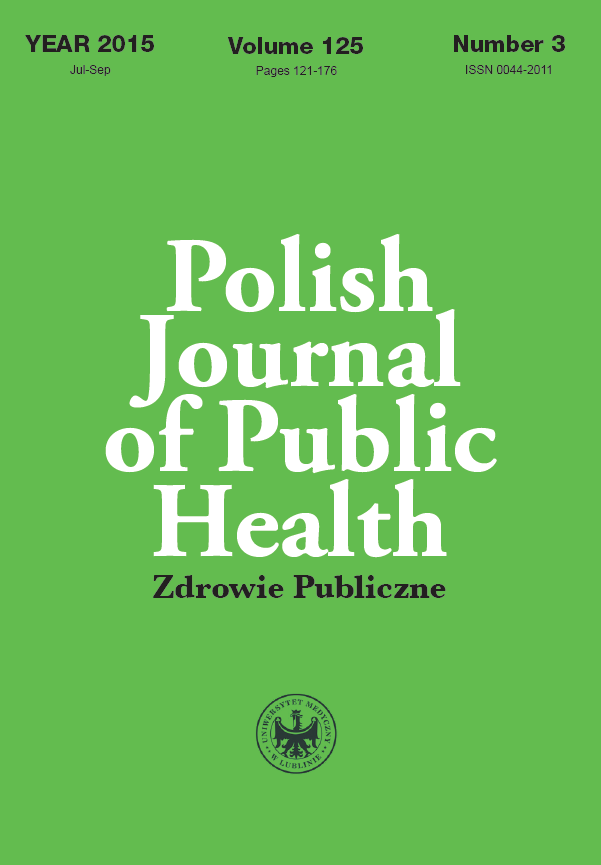Anxiety and stress in miscarriage
DOI:
https://doi.org/10.1515/pjph-2015-0046Keywords:
miscarriage, emotions, anxiety, stressAbstract
Miscarriage is defined as an adverse and unexpected termination of pregnancy before the completion of 22nd week of gestation. Currently, abortion is the most common early reproductive failure. In Poland, more than 40 000 pregnant women a year lose pregnancy due to various reasons. There are many reports in literature on the risk of somatic consequences of miscarriage, while extra-somatic complications resulting from exposure to the strong influence of anxiety and stress, such as, for example: depression and psychosomatic disorders have not been paid too much attention to, yet. Abortion is accompanied by stress and a lot of negative emotions, such as anxiety. They may intensify both due to hospitalization and the need to implement treatment. These negative emotions destroy cognitive power of women, depriving them of their confidence, they can exacerbate the sense of danger, lead to stress and hinder treatment.
References
1. Rutkowska A, Kowalska A, Makara-Studzińska M, Kwaśniewska M. Analiza struktury osobowości u kobiet w pierwszej ciąży prawidłowej i wysokiego ryzyka. Probl Psychiatr. 2011;12(4):420-7.
2. Bielan Z, Macha A, Stankowska I. Psychoseksualne konsekwencje straty w okresie ciąży i porodu. Seksuol Pol. 2010;8(1):41-6.
3. Boyce P, Condon JT, Ellwood DA. Pregnancy loss: a major life event affecting emotional health and well-being. Med J Aust. 2002;176:250-1.
4. Bubiak A, Bartnicki J, Knihnicka-Mercik Z. Psychologiczne aspekty utraty dziecka w okresie prenatalnym. Piel Zdr Publ. 2014;4(1):69-78.
5. Bręborowicz G. Krwawienia we wczesnej ciąży. Położnictwo. Podręcznik dla położnych i pielęgniarek. Warszawa: Wydawnictwo Le¬karskie PZWL; 2012. p. 212-3.
6. Słomko Z. Ginekologia. Warszawa: Wydawnictwo Lekarskie PZWL; 2008. p. 691-9.
7. Giannandrea S, Cerulli C, Anson E, Chaudron LH. Increased Risk for Postpartum Psychiatric Disorders Among Women with Past Pregnancy Loss. J Women’s Health. 2012;22(9):760-6.
8. Nakano Y, Akechi T, Furukawa TA, Sugiura-Ogasawara M. Cognitive behavior therapy for psychological distress in patients with recurrent miscarriage. Psychol Res Behav Managem. 2013;6:37-43.
9. Medjedović V. Anxiety and Depression and Pregnant Women with Previous History of Spontaneous Abortion. Coll Antropol. 2014;(Sup¬pl.1):225-8.
10. Gopal M. Medical management of first trimestr pregnancy loss. In: Ob¬stetric Evidence Based Guidelines. Wyd. 5. USA: Berghella Informa; 2009. p. 2015-9.
11. Więckowska E. Stres jako wskaźnik zaburzenia równowagi emocjonal¬nej – sygnalizacja problemu. Zdr Publ. 2008;118(2):121-3.
12. Murlikewicz M, Sieroszewski P. Poziom depresji, lęku i objawów zaburzenia po stresie pourazowym w następstwie poronienia samoist¬nego. Perinatol Neonatol Ginekol. 2013;6(2):93-8.
13. Lewicka M, Wójcik M. Charakterystyka negatywnych emocji występujących u kobiet w ciąży wysokiego ryzyka. Eur J Med Technol. 2013;1(1):60-7.
14. Rutkowska A, Rolińska A, Kwaśniewski W, et al. Lęk – jako stan i jako cecha w ciąży prawidłowej i ciąży wysokiego ryzyka. Probl Psychiatr. 2011;12(1):56-9.
15. Słomko Z. Ginekologia. Warszawa: Wydawnictwo Lekarskie PZWL; 2008. p. 691-9.
16. Selye H. Stres okiełznany. Warszawa: PIW; 1978.
17. Toffol E, Koponen P, Partonen T. Miscarriage and mental health: Results of population-based studies. Psychiatr Res. 2013:151-8.
18. Dendana M. Messaoudi S, Hizem S, et al. Common polymorphisms in the P-selection gene in women with recurrent spontaneous. Gene. 2012;495(1):72-5.
19. Płotka A. Zdrowy styl życia psychicznego. Lublin: Wyd. NeuroCen¬trum; 2003.
20. Wrześniewski K. Style a trategie radzenia sobie ze stresem. In: I. Heszen-Niejodek, Z. Ratajczak (ed). Człowiek w sytuacji stresu. Ka¬towice: Wyd. UŚ; 1996.
21. Rybakowski J. Zaburzenia lękowe w postaci fobii. In: S. Pużyński, J. Rybakowski, J. Wciórka. Psychiatria, Psychiatria Kliniczna. Wrocław: Elsevier Urban&Partner; 2011. p. 382-94.
22. Wciórka J. Psychopatologia: objawy i zespoły zaburzeń. In: S. Pużyński, J. Rybakowski, J. Wciórka. Psychiatria, Psychiatria Kliniczna. Wrocław: Elsevier Urban&Partner; 2010. p. 382-94.
23. Morley L, Shilito J, Tang T. Preventing recurrent miscarriage of un¬known etiology. Obstet Gynaecol. 2013;15:99-105.
24. Blackmore RE, Côté-Arsenault D, Tang W, et al. Previous prenatal loss as a predictor of perinatal depression and anxiety. Br J Psychiatry. 2011;198:373-8.
25. Cheung C, Chan Ch, Ng E. Stress and anxiety depression levels follow¬ing first – trimestr miscarriage: a comparison between women who con¬ceived naturally and women who conceived with assisted reproduction. Int J Obstet Gynecol. 2013;120:1090-7.
26. Łuczak-Wawrzyniak J, Czarnecka-Iwańczuk M, Bukowska A, Konofal¬ska N. Wczesne i późne psychologiczne skutki utraty ciąży. Ginekol Pol. 2010;81:374-7.
27. Siek S. Wybrane metody badania osobowości. Warszawa: Wydawnict¬wo Teologii Katolickiej; 1993.
28. Sękowski A, Płudowska M. Niepokój egzystencjalny i lęk u osób o zróżnicowanym poziomie zdolności twórczych. Lublin: Wyd. Kul; 2011. p. 14.
29. Śliwak J. Niepokój a poziom altruizmu. Przegl Psychol. 2002;45(2):229.
30. Betts SK, Williams GM, Najman JM, Alati R. Maternal depressive anx¬ious, and stress symptoms pregnancy predict internalizing problems in adolescence. Depression and Anxiety. 2014;31:9-18.
31. Watrowski R, Rhode A. Validation of the Polish version of the Hospital Anxiety and Depression Scale in three populations of gynecologic pa¬tients. Arch Med Sci. 2014;10(3):517-24.
32. Lamers F, van Oppen P, Comijs HC, et al. Comorbidity patterns of anxi¬ety and depressive disorders in a large cohort study: the Netherlands Study of Depression and Anxiety (NESDA). Psychiatry. 2011;72:341-8.
33. Heszen-Niejodek I. Stres i radzenie sobie – główne kontrowersje. In: I. Heszen-Niejodek, Z. Ratajczak (ed). Człowiek w sytuacji stresu. Problemy teoretyczne i metodologiczne. Katowice: Wydawnictwo Uni-wersytetu Śląskiego; 2000. p. 20-1.
34. Bielan Z, Macha A, Stankowska I. Psychoseksualne konsekwencje straty w okresie ciąży i porodu. Seksuol Pol. 2010;8(1):41-6.
35. Toffol E, Koponen P, Partonen T. Miscarriage and mental health: Results of two population – based studies. Psychiatry Res. 2013;205:151-8.
36. Heszen I, Sęk H. Wybrane psychologiczne aspekty ginekologii i położnictwa. Psychologia Zdrowia w wybranych dziedzinach medy¬cyny. Psychologia Zdrowia. Warszawa: Wydawnictwo Naukowe PWN; 2012.
37. Faisal-Cury A. Huang H, Chan YF, Menezes PR. The Relationship Be¬tween Depressive/Anxiety Symptoms During Pregnancy/Postpartum and Sexual Life Decline after Delivery. JSM. 2013;10:1343-9.
38. Sokołowska M. Relacja psychoterapeutyczna w terapii poznawczo-behawioralnej pacjentów z zaburzeniami osobowości. Psychoterap. 2013164(1):23-30.
Downloads
Published
Issue
Section
License
Copyright (c) 2015 Polish Journal of Public Health

This work is licensed under a Creative Commons Attribution-NonCommercial-NoDerivatives 3.0 Unported License.


